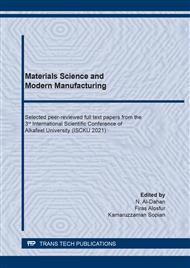[1]
Fuknda, M. And Mito,K . "Solid-state Dye Laser with photo Induced Distributed Feed Back. 2000 J. Appl.phys., Vol.39.
Google Scholar
[2]
Huang X, El-Sayed MA. Gold nanoparticles: Optical properties and implementations in cancer diagnosis and photothermal therapy. Journal of advanced research. 2010 Jan 1; 1(1):13-28.
DOI: 10.1016/j.jare.2010.02.002
Google Scholar
[3]
Alyaa Abd-Almehdi. Preparation of some dyes as laser detectors and study their structural optical and electrical properties. Master Thesis, University of Kufa, (2019).
Google Scholar
[4]
Hollas, J. M.,Modern Spectroscopy,, John Wiley and sons Ltd, The Atrium, Southern Cate Chionester, west Sussex PO19 8SQ, England, (2004).
DOI: 10.1017/s0001924000086929
Google Scholar
[5]
Hussein SK. Structural and optical properties of thin films of transparent conductive oxides (TCO, (SnO2, SnO2: F), (ZnO, ZnO: F) prepared on glass by thermochemical spraying method. Master Thesis, University of Kufa, (2011).
Google Scholar
[6]
Al-Taie S A. Study the effect of some physical and chemical parameters on the emission intensity of laser active medium. Master Thesis, University of Babylon, (2017).
Google Scholar
[7]
Fukuda M, Mito K. Solid-state dye laser with photo-induced distributed feedback. Japanese Journal of Applied Physics. 2000 Oct;39(10R):5859.
DOI: 10.1143/jjap.39.5859
Google Scholar
[8]
Phyllis AL. Iodine and iodine compounds in Ullmann's Encyclopedia of Industrial Chemistry. Wiley-VCH, Weinheim. 2005;9(3):123-453.
Google Scholar
[9]
ACC. American Chemistry Council. Acetone VCCEP, p: 15, based on 199, September 10,(2003).
Google Scholar
[10]
Nayef OM. Spectral study of energy transfer and competing processes in laser dyes (Kumarin 522 and Rodamine 101). Journal of Engineering and Technology. 2008;26(5).
Google Scholar
[11]
Ibrahim W N. Increase the conductivity of the cadmium toluoride films. Master Thesis, University of Technology, (2009).
Google Scholar
[12]
Hayat K, Gondal MA, Khaled MM, Ahmed S, Shemsi AM. Nano ZnO synthesis by modified sol gel method and its application in heterogeneous photocatalytic removal of phenol from water. Applied Catalysis A: General. 2011 Feb 15;393(1-2):122-9.
DOI: 10.1016/j.apcata.2010.11.032
Google Scholar
[13]
Tomilin FN, Rogova AV, Kaufman EV, Drevolsky AS, Gerasimova MA, Slyusareva EA. Solvent effect in the theoretical absorption and emission spectra of fluorescein dyes. InXIV International Conference on Pulsed Lasers and Laser Applications 2019 Dec 11 (Vol. 11322, p. 113220O). International Society for Optics and Photonics.
DOI: 10.1117/12.2548739
Google Scholar
[14]
Mahajan PG, Bhopate DP, Kolekar GB, Patil SR. FRET sensor for erythrosine dye based on organic nanoparticles: application to analysis of food stuff. Journal of fluorescence. 2016 Jul 1; 26(4): 1467-78.
DOI: 10.1007/s10895-016-1839-7
Google Scholar


